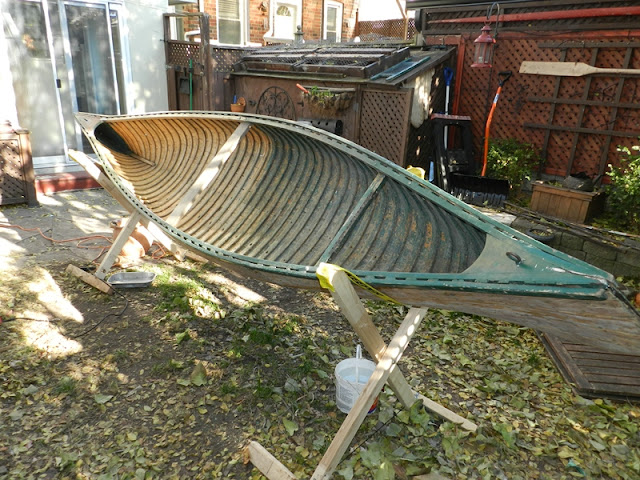
Friday, December 25, 2020
Season's Greetings

Wednesday, December 16, 2020
Trapper's Canoe Restoration: Analysis of the hull exterior
After removing the fiberglass cloth off the exterior of the hull and methodically scraping away bits of resin, the cedar planking was now fully exposed. Basically the condition of the planking could now be assessed.
A centre plank has a hole and will need to be replaced. This should be an easy repair since the planking lies flat in this area.
Basically this canoe has a little bit of everything needed for repairs but it still seems to be in great overall condition for a heavily used, functional boat.
The next part of the restoration is posted at this link HERE.

Sunday, December 6, 2020
Cedar "Huron" Paddle Replica
Coming across three nearly identical versions of a model paddle in the collections of the Smithsonian, New York's Metropolitan Museum and the Danish National Museum provided the motivation to attempt a full sized version.
All three model paddles to be made of cedar and I happened to have a scrap piece of red cedar with decent grain. A small 55 inch paddle could be made from the board after cutting around small knots. Shaping out the blank and thinning down the blade with the axe produced lots of scrap for summertime campfires.
The diamond shaped blade features notched shoulders with the face divided into faded red and blue hemispheres. The blade tip shaped into a blunt point. Ended up using some milk paints with similar colours to mimic the decorative effect. The Met Museum cites the model as being a "Maliseet style" but the Smithsonian and Danish samples mention a provenance stemming from the Quebec / St. Lawrence river valley with the Danish sample mentioning it was was made by Quebec Huron / Wendat as a tourist item. This makes the most sense as by the mid 19th century the Wendat in the Quebec city region were well known for manufacturing and marketing such models for the burgeoning tourist trade. As such I've labelled this paddle as a "Huron".

Tuesday, December 1, 2020
Trappers Canoe Restoration: Stripping the interior
One of the least enjoyable parts of any canoe restoration is the stripping of the old interior varnish. It takes time, uses smelly chemicals and cannot be rushed. This boat is made worse by the fact that the interior was coated in heavy layers of green paint. Performing the work outside is a must and during a warm stint here in the city, I set up to commence the necessary work.
I've never stripped a canoe before, but a suggestion to first use a heat gun and scraper to remove the top layers of paint was suggested on an online forum. I started on a heavily painted section along the bilge and sure enough, most of the paint softened up and could be carefully scraped off without scratching up the delicate cedar ribs and planking. After cleaning up a small section about a foot wide, I tested out the chemical stripper in the area and the results were pretty good...
Working section by section, some parts of the hull were left with stubborn bits of paint after being scraped with heat. They required at least two treatments of chemical stripper before getting rid of the green paint leaving behind a sludge that looked like creamed spinach.
In order to access the spots under the seats, they needed to be removed. Unfortunately the steel carriage bolts securing them in place had corroded significantly and were a real chore to remove. I had to cut some of them with an angle grinder. Pounding them out with a hammer they seemed to get stuck in the inwale. So I ended up drilling a deep hole in the heads and then placing my pyrography pen set a full heat into the spot in order to heat up the bolts. It worked pretty well. At one point my finger tip touched the bottom of the cut bolt and I got a serious blistered burn.
The board covering the broken cane on the bow seat was easily removed. It seems the plank was also serving a structural purpose because the seat fell apart once removed from the hull.
In order for the hull to maintain some of its shape, I kept one crossbar of the seat at the bow while stripping the other end. Here is the result at the halfway point...
 |























